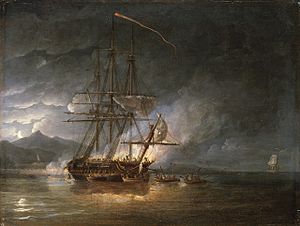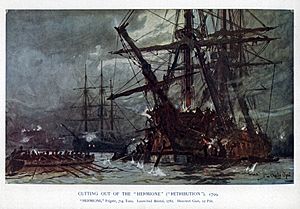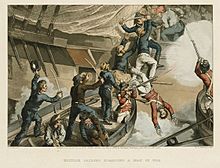Cutting out of the Hermione facts for kids
Quick facts for kids Cutting out of the Hermione |
|||||||
|---|---|---|---|---|---|---|---|
| Part of the French Revolutionary Wars | |||||||
 Santa Cecilia, the former Hermione, is cut out at Puerto Cabello by boats from HMS Surprise, Nicholas Pocock |
|||||||
|
|||||||
| Belligerents | |||||||
| Commanders and leaders | |||||||
| Strength | |||||||
| 100 | 351 1 frigate |
||||||
| Casualties and losses | |||||||
| 12 wounded | 120 killed 97 wounded 1 frigate captured |
||||||
The Cutting out of the Hermione was an exciting naval battle. It happened in Puerto Cabello, Venezuela, on October 25, 1799. A British ship, HMS Hermione, had been taken by its crew after a serious mutiny. They gave the ship to the Spanish.
The Hermione was now called Santa Cecilia. It was in a heavily guarded port. A British ship, HMS Surprise, was sent to get it back. This type of mission was called a cutting out operation. It meant a surprise attack by small boats, usually at night. The goal was to board and capture an enemy ship that was anchored. This was a popular tactic in the late 1700s.
A Ship's Troubled Past
HMS Hermione was a frigate of the Royal Navy. It was commanded by Captain Hugh Pigot. In September 1797, some of the crew rebelled against their captain. They harmed him and other officers. Fearing punishment, the crew sailed Hermione to a Spanish port. They handed the ship over to the Spanish authorities. The mutineers claimed they had left the officers in a small boat. This was similar to the famous Mutiny on the Bounty.
The Spanish took the Hermione into their navy. They renamed her Santa Cecilia. For two years, she stayed in the port of La Guaira. Her crew included 25 of her former British sailors. These sailors were kept under Spanish guard.
News of the Hermione's fate reached Admiral Sir Hyde Parker. He learned about it when HMS Diligence captured a Spanish ship. Admiral Parker demanded the return of the ship and the mutineers. However, the Spanish governor only moved the ship to Puerto Cabello. Parker then sent HMS Magicienne to try and negotiate. He also offered rewards for information. This led to the capture of 33 mutineers.
Eventually, Parker heard that Santa Cecilia was in Puerto Cabello. He ordered HMS Surprise to watch the port. Captain Edward Hamilton of Surprise felt it was important to get the ship back. He decided to plan a daring attack. He asked Admiral Parker for more men. Parker thought the plan was too risky and refused. But Hamilton decided to go ahead anyway.
The Daring Attack
The Santa Cecilia was well-defended. About 400 Spanish sailors were on board. Captain Don Ramón de Chalas commanded them. The ship was also protected by two shore batteries. These batteries had about 200 guns.
Captain Hamilton carefully planned the attack. He had about 100 seamen and marines in his boats. They all wore dark clothes to stay hidden. The boats were arranged in two groups. One group would attack the starboard (right) side of the ship. The other group would attack the larboard (left) side. Each boat had a specific part of the ship to secure.
Secrecy was very important for the attack. But Hamilton's boats were spotted by two Spanish gunboats. Some boats also got stuck in a floating barrier called a boom. They quickly got free, but the Spanish shore batteries were alerted. They started firing. The crew of Santa Cecilia was ready for the British. As the British boats approached, the Spanish fired their muskets. They also accidentally fired on their own gunboats, causing confusion.
Despite the chaos, the British boarded Santa Cecilia. At first, the first group to board was pushed back. Captain Hamilton found himself fighting four Spaniards alone. He was knocked down by a musket butt. Just then, the other group of boats arrived. The Marines charged onto the main deck. They saved Hamilton and drove the Spaniards back. The Spanish sailors were caught in a crossfire. They were forced below deck. The fight continued inside the ship.
While the battle raged below deck, Hamilton's sailors worked quickly. They cut the ropes holding Santa Cecilia in place. They also unfurled the sails to catch the wind.
Captain de Chalas was wounded and captured. He was taken below deck. The remaining Spanish sailors soon surrendered.

The shore batteries continued to fire as the ship sailed away. They hit the ship several times, but it wasn't badly damaged. Hamilton ordered his crew not to fire back or show any lights. This tactic worked. The Santa Cecilia sailed safely out of danger.
By 2:00 a.m., the battle was over. The firing from the shore batteries stopped. The boats with Santa Cecilia met up with HMS Surprise by 3:00 a.m.
What Happened Next
The Spanish lost 120 men. Another 231 were taken prisoner, and 97 of them were wounded. Most of the prisoners were returned to the port the next day. Fifteen Spanish sailors escaped by jumping overboard. Twenty more escaped in a small boat. The British had no deaths. Only twelve men were wounded, and four were seriously hurt. Captain Hamilton himself was among the wounded. He had been hit on the head and had wounds from a sabre, pike, and grapeshot.
Admiral Parker had the recaptured Hermione renamed HMS Retaliation. Later, the Admiralty ordered her to be renamed HMS Retribution. Captain Hamilton received a lot of prize money. He became very wealthy and even turned down a pension.
For his brave actions, Hamilton received many honors. He was made a knight. He also became a Knight Commander of the Order of the Bath. Later, he was made a baronet. The Jamaica House of Assembly gave him a valuable sword. The City of London also honored him. In 1847, he received a gold medal for recapturing the Hermione. The surviving sailors from the action also received a special medal.



